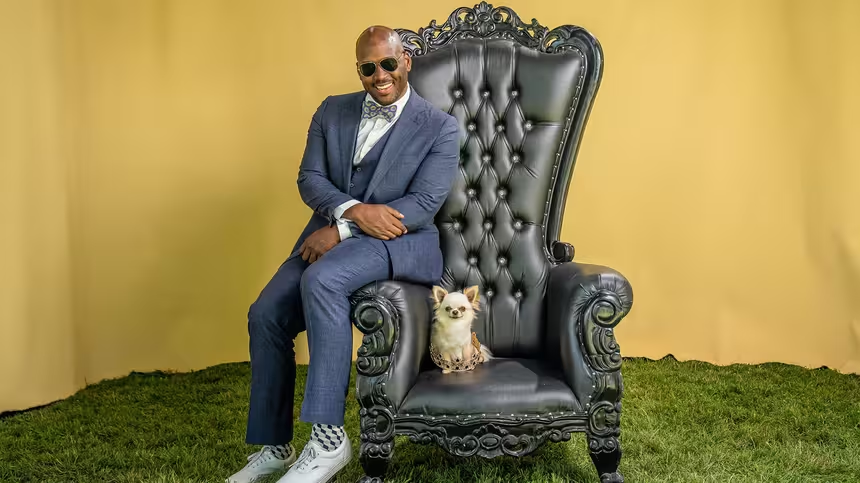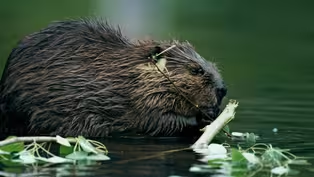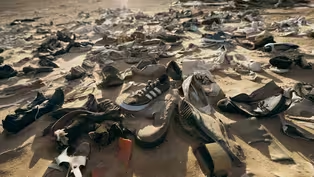
Shear Force: How Sheep Reshaped Scotland
Clip: Season 2 Episode 3 | 5m 42sVideo has Closed Captions
From Highland pastures to global fashion, wool’s history is woven into Scotland’s identity.
Wool has transformed Scotland’s landscapes, livelihoods, and legacy. Shane joins fashion historian Sally Tuckett at the Royal Highland Show and shepherd Joe Bakeron in the rugged hillsides of Scotland to explore how selective breeding and the Highland Clearances shaped today’s sheep-filled pastures — and how wool still weaves its influence through our clothes.
Problems playing video? | Closed Captioning Feedback
Problems playing video? | Closed Captioning Feedback

Shear Force: How Sheep Reshaped Scotland
Clip: Season 2 Episode 3 | 5m 42sVideo has Closed Captions
Wool has transformed Scotland’s landscapes, livelihoods, and legacy. Shane joins fashion historian Sally Tuckett at the Royal Highland Show and shepherd Joe Bakeron in the rugged hillsides of Scotland to explore how selective breeding and the Highland Clearances shaped today’s sheep-filled pastures — and how wool still weaves its influence through our clothes.
Problems playing video? | Closed Captioning Feedback
How to Watch Human Footprint
Human Footprint is available to stream on pbs.org and the free PBS App, available on iPhone, Apple TV, Android TV, Android smartphones, Amazon Fire TV, Amazon Fire Tablet, Roku, Samsung Smart TV, and Vizio.
Buy Now

Surprising Moments from Human Footprint
Do you think you know what it means to be human? In Human Footprint, Biologist Shane Campbell-Staton asks us all to think again. As he discovers, the story of our impact on the world around us is more complicated — and much more surprising — than you might realize.Providing Support for PBS.org
Learn Moreabout PBS online sponsorship(bright music) (announcer) Ladies and gentlemen, we’re gonna move on to the Scottish National.
(Sally) Oh, this should be good.
National champions.
Very important.
(whooshing) (Shane) And there’s no better place to witness our obsession with wool than the Golden Shears World Sheep Shearing Championships.
(indistinct announcements) How are you doing with the accents?
85% to 90%.
That’s pretty good.
(chuckles) (intense music) (indistinct announcements) (shears snipping) ♪ (clippers buzz) (Shane) Feel like a lot of-- a lot of tension is building right now.
(indistinct announcements) My understanding has dropped to about 30% now.
(Sally laughs) (indistinct announcements) (hip-hop music) The competitors on stage are some of the best, and fastest, in the world, clocking about a sheep a minute.
(indistinct announcements) ♪ (goat bleats) (applause, cheering) (soft music) (Shane) The shearing competition is just one part of the Royal Highland Show, a centuries-old Scottish gathering of majestic horses, big-boned cattle, and a kaleidoscope of sheep breeds wearing the finest wool around.
(mellow music) My guide is fashion historian Sally Tuckett.
(Sally) I think looking to the past and how people made clothes in the past, the relationship with the raw material can tell you so much about a past society.
(hip-hop music) (Shane) Whether she’s teaching at the University of Glasgow... ♪ ...or exploring Scotland’s beaches with her adventure buddy Margo... (panting) ...Sally spends a lot of time thinking about wool.
♪ (audible chewing) (sheep bleats) As an American, when I think about Scotland, -Scotch, obviously.
-Obviously.
-Uh, you got castles.
-Yup.
-Uh...kilts.
-Yup.
Grass and sheep.
I think--I think you’ve got it.
(Shane laughs) (majestic music) You’ll see sheep all over the place today, that doesn’t mean they were necessarily there to begin with.
♪ (Shane) About 10,000 years ago, people in modern-day Turkey discovered they could raise the wild Mouflon sheep for meat, milk, and fur.
Over time, those animals would become modern sheep, the second animal ever domesticated.
(mellow music) Sheep reached the British Isles about 6,000 years ago.
And through generations of selective breeding... (clippers buzzing) ...we transformed these ancient scruffy breeds into today’s luxuriant fluff balls.
(majestic music) And as humans changed sheep, sheep began to reshape the landscape.
(whooshing) (hip-hop music) (Sally) 6,000 years ago, Scotland was much more of a woodland.
♪ (Shane) As wool became a vital part of Scotland’s economy, more and more forests were converted into pasture.
(Sally) When trees have been removed, and if sheep are brought in, that stops any trees regrowing.
(soft music) (Shane) By the late 1800s, most of Scotland’s remaining forests were in the Highlands.
(Sally) The Highland Clearances are an emotive, possibly very misunderstood, and highly symbolic part of Scottish history.
(Shane) The Highlands were home to thousands of tenant farmers working on land belonging to upper-class landowners.
(Sally) The Highland landowners decided that sheep were probably more stable form of income.
Sheep don’t need that many people to look after them, so, whole communities would be moved off the land and replaced with thousands of sheep.
(Shane) It was a period of social and environmental upheaval.
Landowners cleared the remaining old-growth forests to make way for sheep.
(Sally) And so that’s fundamentally changed the landscape of the Highlands.
♪ (Shane) Today, Scotland’s pastures are home to more than six million sheep.
(whooshing) And they’ve become an undeniable part of Scotland’s national identity.
(sheep bleating) How long have you been doing this?
(Joe) We’ve been doing this for 31 years, yeah.
-Okay.
-So, yeah, Mum and Dad-- -How old are you?
-I am 31.
(Shane laughs) (Shane) Okay.
(hip-hop music) When Joe Baker isn’t out hunting in his tweeds... ♪ ...he’s busy running Scotland’s 2023 Sheep Farm of the Year.
♪ And he’s got some very capable assistants.
(dog panting) (Joe) Zoey, come on.
Good girl.
Zoey.
(Zoey barks) -(grim music) -(sheep bleating) ♪ (whooshing) ♪ (Joe whistles) Mist, here.
(Mist pants, barks) (hip-hop music) Come by, good girl, come by, that’s it.
(whooshing) Good girl, good girl.
(thundering hoofbeats) (Shane) Turns out, managing the second animal ever domesticated means enlisting the first.
(Joe) Way.
So, "way" means right.
"Come by" means left.
(sheep bleating) (Shane) I’ve never seen nothing like it.
(whooshing) (sheep bleating)
The Beaver Boom: How One Rodent Shaped a Continent
Video has Closed Captions
Clip: S2 Ep3 | 5m 41s | Shane explores how beavers once ruled North America — and how they might again. (5m 41s)
Buried in Style: Fashion’s Final Destination
Video has Closed Captions
Clip: S2 Ep3 | 12m 3s | From catwalk to castoff, Shane follows our tossed threads to the Chilean desert. (12m 3s)
Video has Closed Captions
Preview: S2 Ep3 | 30s | From runway to throwaway, Shane suits up to discover the global impact of our fashion addiction. (30s)
Providing Support for PBS.org
Learn Moreabout PBS online sponsorship
- Science and Nature

Explore scientific discoveries on television's most acclaimed science documentary series.

- Science and Nature

Follow lions, leopards and cheetahs day and night In Botswana’s wild Okavango Delta.












Support for PBS provided by:


